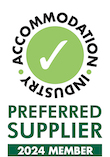4 Easy Steps to Improve the Cleanliness of Your Caravan Park Washroom
Hygiene in washrooms is essential, especially in shared spaces such as caravan parks. If neglected, washrooms provide favourable conditions for germs to thrive.
Unclean washrooms are unsightly and pose a health risk to both the guests and staff of caravan parks. And ultimately, they reduce the profitability of such a business.
The good news is that maintaining clean washrooms isn’t as hard as you may think. With a few simple steps, your washrooms will be spotless.
The Perks of Clean Restrooms in a Caravan Park
Reduced Germs and Bacteria Transference
Although washrooms are spaces dedicated to hygiene, they can be very unsanitary. Dirty washrooms pose a significant risk of causing diseases and infections.
Thankfully, regular cleaning reduces these risks and safeguards the health of both guests and staff.
Improved Business
Clean and sanitary washrooms help boost goodwill towards your establishment. It shows guests your attention to detail, and this put them at ease, which is great for business.
Clean and Healthy Environment
Clean washrooms help create a tranquil environment within the park. Proper cleaning practices prevent offensive odours. This makes the facilities more pleasant for the guests, adding to their satisfaction.
Remember, a happy customer is a returning customer.
How to Clean Your Caravan Park Washroom in Four Easy Steps
1. Focus on the Germ Hotspots When Cleaning
 Image: courtesy
Image: courtesy
Most people assume that the toilet bowl contains the highest number of germs in the washroom. However, research shows that there are far more dangerous surfaces in the washroom.
We clean the toilet using special cleaners, which eliminate stains, odours, and germs. But not every surface in the washroom gets this treatment.
Here are a few of the most common germ hotspots and how to clean them:
Shower Curtains
Shower curtains are crawling with germs and bacteria, thanks to the damp conditions. The most common of which is the bacterium Serratia mercescens.
This is the bacterium responsible for the slimy pink film on shower curtains.
To clean the shower curtains:
- Run them in the wash per the manufacturer’s instructions.
- Toss in a few old towels with the curtains to act as scrubbers.
- Use the hottest water setting possible and a bit of vinegar to get rid of soap scum and mildew.
- Allow the curtains to dry completely.
Tip: Bacteria grow slower on nylon, making it a better choice for shower curtains.
The Floor
The floor is the second dirtiest surface in the washroom. We don’t clean and disinfect the floors nearly as often as we should.
The process for cleaning your washroom floors will vary depending on the floor.
For example, bleach will not react with porcelain floors, but it will damage some natural stone floors.
That said, you need to:
Clean – this refers to the process of removing visible dirt and germs using soap and water. You can use a mild detergent soap depending on your flooring material.
Disinfect – this refers to the use of chemicals to kill, or rather, inactivate germs. Common household disinfectants include alcohol, bleach, and hydrogen peroxide. Choose one that best suits your flooring material.
Always clean before disinfecting for best results.
To clean dirty grouting, you can dip a grout brush in bleach and scrub the discoloured areas. Remember to ensure the room is well ventilated, and rinse well after.
The Toilet

Image: courtesy
Although not as dirty as you might’ve initially thought, toilets are still full of germs and bacteria.
To clean the toilet:
- Put the toilet seat down and flush the toilet.
- Lift the seat and use the toilet brush to push the water down to reduce the waterline.
- Spray toilet cleaner under the rim and around the toilet bowl.
- Allow for recommended contact time.
- Use the toilet brush to clean the bowl, under the rim and waterline.
- Flush the toilet.
- Apply a disinfectant to the outside of the bowl, the piping, toilet seat, lid and cistern.
- Allow for the recommended contact time.
- Wipe down with a clean cloth.
Note: Always close the toilet lid when flushing. Every flush sends microbes into the air and surfaces in the washroom.
Don’t forget to clean the toilet brush when done. You can do this by securing it between the seat and basin and pouring bleach over the bristles.
Rinse with clean water and clean out the brush container with warm soapy water and disinfect as well.
Be sure to disinfect the tissue dispenser and restock the toilet paper rolls and paper towels. After all, a clean washroom is a well-stocked washroom.
Faucet Handles
According to a study by the NFS, sink handles can contain up 600 times more microorganisms than toilet handles.
Clean faucet handles with disinfecting cleaners or wipes recommended by the EPA. This applies to the paper towel dispensers as well.
2. Prevent Cross-Contamination
Cross-contamination refers to the transfer of germs from one surface to another. It occurs mainly between our hands and high contact surfaces.
In the washroom, these are:
- The flush handle
- Toilet seats
- Door handles
- Light switches
- Bathroom taps
- Buttons on hand dryers
- Waste bins
Clean and disinfect these surfaces regularly with the appropriate products to curb the spread of germs and diseases.
3. Use the Right Personal Protective Equipment
You must put on personal protective equipment (PPE) before cleaning the washrooms. These items protect you from harmful microbes, as well as the harsh cleaning chemicals.
The necessary protective equipment when cleaning toilet facilities includes:
- Closed footwear
- Overalls
- Gloves
- Eye protection
- Face mask
If you are going to mix poisonous or highly flammable products, you may also need to wear a respirator mask.
Here are the key benefits of wearing PPE when cleaning washrooms:
- They protect you and your employees from dangerous and disease-causing microorganisms preventing illnesses.
- They reduce risk should exposure to harmful germs and bacteria occur, potentially saving yours or your employee’s life.
- They prevent cross-contamination and the spread of germs from the washroom to other areas.
- They prevent staff emergencies due to prolonged contact with cleaning chemicals.
- They boost morale because employees know that they work in a safe and secure work environment. This, in turn, leads to a more productive workforce and cleaner facilities.
 Image: courtesy
Image: courtesy
4. Reduce Points of Contact through Automation and Sensors
Contact with frequent-touch surfaces is one of the most common ways through which germs and bacteria spread. Reducing contact with these surfaces will reduce the rate of germ transference.
So how do you go about reducing contact with surfaces in the washroom?
The answer is automation.
You can use technology to enable guests to use washrooms with minimal contact with high-risk surfaces.
The most common automation points in washrooms are:
Automatic Toilet Flushers
These detect when a user is done and automatically flush. They help ensure the highest standards of hygiene by eliminating the need for physical contact with the toilet.
They also ensure that the washrooms remain clean and flushed at all times.
Automatic toilet flushers contain an infrared LED projector and receiver that detect when a person is on the loo or not.
A microchip controls the LED projector, which shoots infrared beams at regular intervals. If the light doesn’t reflect back, nothing happens. But when someone is on the toilet, the light reflects off them, and the sensor detects that there’s someone there.
When the person leaves and the beam doesn’t reflect anymore, the sensor activates the flushing mechanism.
Automatic Faucets

Image: courtesy
Automatic faucets are another brilliant tool to help reduce germ transference in the washroom.
They use sensors to detect when your hands are under the tap and turn on the water. And when you remove your hands, they turn off the water.
To best understand how this happens, we need to take a look at the four major components of an automatic faucet. These are:
The Sensor
This is a tiny infrared light positioned at the base of the spout. It detects when your hands are under the spout and signal to turn the valve on or off.
The Solenoid Valve
The solenoid controls the flow of water. It consists of an electromagnet that works with the sensor to open or shut the valve depending on changes in electric polarity.
The Power Source
Automatic faucets need electricity to power the sensor and the solenoid that operates the water valve.
The power source can be from dry cells or a low voltage current from an AC transformer.
Note, however, that transformer powered faucets get damaged over time and need repairs.
The Spout
This is the part that houses all the components. Your choice of spout will depend on your personal preference or the design of the washrooms.
Automatic Soap and Sanitiser Dispensers

Image: courtesy
Automatic dispensers are a must-have in caravan park washrooms. They reduce germ transference and regulate the amount of soap or sanitiser dispensed.
Automatic dispensers work through:
Infrared sensors
These work a lot like the ones mentioned in the automatic toilet flushers. But instead of a flush, the sensors trigger a dispensation of soap or sanitizer.
Photo Sensors
This is the most common and readily available version of infrared technology. It uses a light source and a light sensor to detect disruption. When you place your hand under the ray of light, it activates the pump mechanism.
Give Your Staff and Customers the Respect of a Clean Washroom
Although we don’t talk about them much, washrooms are an essential part of everyday life. In caravan parks, washrooms dictate a clients' perception of the establishment.
Clean washrooms make the guest feel at ease and know that they are in safe hands. Dirty washrooms, on the other hand, are a sign of neglect and can negatively impact your business.
Additionally, sanitary washrooms are an integral part of fighting the spread of diseases. Their importance cannot be overstated.
Follow these simple steps to maintain a clean and well-stocked caravan park washroom, and watch your business grow.
Source: Martyn Wright















